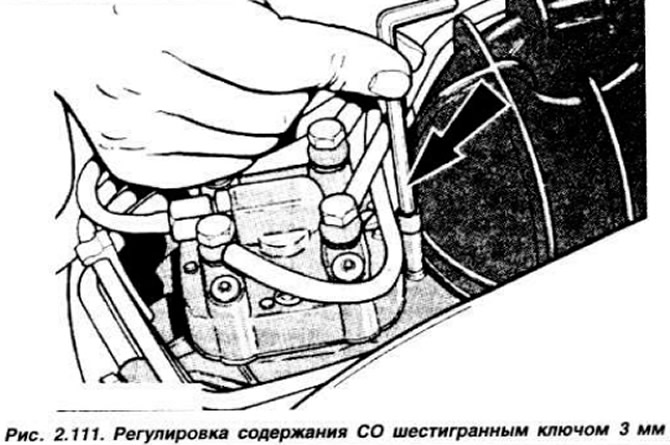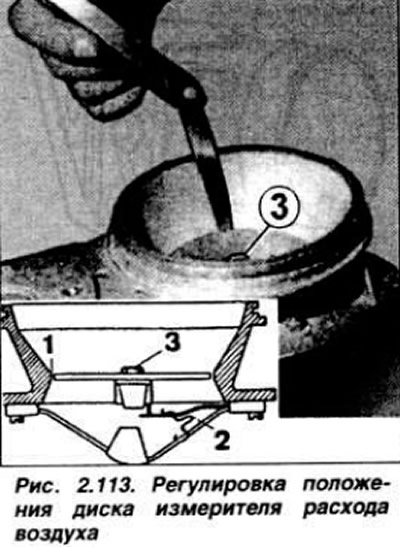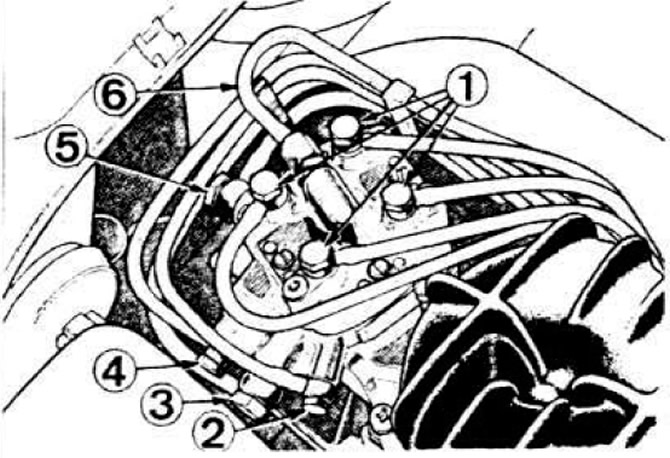Idle adjustment
The idle speed of the engine is adjusted with the engine warmed up to operating temperature, with the ignition timing correctly set, the air filter element clean and the power consumers turned off. On vehicles with an automatic transmission, the selector lever must be in position «R». Connect a control tachometer according to the operating instructions, start the engine and measure the idle speed of the crankshaft, which should be within 750-850 rpm, otherwise adjust. To do this, let the engine run for 30 seconds at a crankshaft speed of 3000 rpm. then set it to idle. Rotating screw 1 (rice. 2.105), adjust the crankshaft speed.
NOTE: If the fuel lines were disconnected from the fuel injectors before adjustment, the engine must run several times at 3000 rpm and at least 2 minutes at idle speed before starting the adjustment.
To adjust the content of carbon monoxide (SO) in the exhaust gases, connect a gas analyzer, unscrew the plug. closing the screw for adjusting the CO content on the body of the dispenser-distributor, and let the engine run for 30 s at a crankshaft speed of 3000 rpm, and then switch it to idle. Turning the adjusting screw with a 3 mm hex wrench (fig 2.111), bring the CO content in the exhaust gases to the norm of 1.0-1.5%.

NOTE: During adjustment, do not remove the key from the adjusting screw and do not press it, do not increase engine speed without removing the key from the screw.
Throttle opening is adjusted at the factory and is not adjustable in operation.
Air flow meter
Disconnect the air duct from the air flow meter to gain access to its disk. Check the operation of the drive lever of the spool of the dispenser-distributor in the following order. Turn on the starter for about 10 s. Using a screwdriver or magnet, lift the pressure plate of the meter (pic. 2.112).

The lever must provide the same resistance to movement throughout the entire travel of the disk. When the disc is lowered quickly, the lever must not show any resistance. Otherwise, replace the air mass meter. If it is difficult to move the lever up, this indicates a sticking of the spool, so the fuel dispenser must be replaced. After that, check the engine oil temperature, which should be above 50°C. Start the engine for about 15 seconds and check the position of the disk in the diffuser. The top of the disc must be flush or no more than 0.5 mm below the narrowest part of the diffuser (pic. 2.113).

To adjust its position, lift the disc up and compress or unclench the wire clamp located under the disc 2 to obtain the correct position of the pressure disc. Do not bend the leaf spring when the disc stops. Check engine idle speed as described above.
Fuel pump
Disconnect the connector block from the pump and connect the control pump to the plugs of the wiring block. Turn on the ignition. The control pump should light up. If it does not light, check the wiring and the fuel pump relay.
Checking the performance of the fuel pump
Disconnect pipe 3 from the fuel distributor (pic. 2.114) draining the fuel into the tank, instead of it, connect a short hose, the end of which is lowered into a measuring vessel.
 Pic. 2.114. Fuel dispenser fittings.
Pic. 2.114. Fuel dispenser fittings.
1 - to the fuel injectors; 2 - to the starting nozzle; 3 - fuel drain; 4 - from the control pressure regulator: 5 - fuel supply; 6 - to the control pressure regulator.
Disconnect the fuel pump relay and bridge the plugs «30» And «87» short jumper wire blocks (The relay is located on the front panel of the body behind the glove box). Switch on the ignition and let the pump run for 30 seconds. The amount of fuel supplied to the vessel must be at least 750 cm3 Otherwise, check the pump and fuel filter. Connect the fuel pump relay connector.
Fuel pressure check
Relieve pressure by loosening fitting 3 (pic. 2.114) the fuel drain hose from the control pressure regulator, after placing a rag under it.
Disconnect fuel line 2 (pic. 2.115), connecting the control pressure regulator to the dispenser-distributor, and instead connect a control pressure gauge with a cock to measure both the flow pressure and the inlet pressure.
 Pic. 2.115. Pilot pressure regulator connections.
Pic. 2.115. Pilot pressure regulator connections.
1 - electrical connector: 2 - fuel supply fitting; 3 - fuel drain fitting.
Remove air pockets. To do this, start the engine, set the pressure gauge cock to the position for controlling the passage pressure and lower the pressure gauge so. so that it hangs on the hoses. Open the manometer cock. Start the engine and set the idle speed. Read the value of the fuel pressure in the system on the pressure gauge, which should be within 4.7-5.5 kgf / cm2. Otherwise, find and eliminate the cause of the pressure deviation from the norm or replace the dispenser
Control pressure test
Disconnect the connector blocks of the control pressure regulator, auxiliary air supply valve, time-delay thermostat and starter nozzle. Open the cock of the control pressure gauge. Start the engine and read the control pressure on the pressure gauge. which should be 0.9 kgf/cm2 /10°С; 1.35 kgf/cm2 /20°С; 1.7 kgf/cm2 /30°С; 2.15 kgf/cm2 /40°C. Make sure the engine is hot (otherwise, turn on the ignition and wait 6 minutes to warm up the bimetallic spring of the control pressure regulator), reconnect all disconnected connectors and start the engine. The pressure shown by the pressure gauge should increase to 3.4-3.8 kgf / cm2. If the pilot pressure is not within the specified limits, replace the pilot pressure regulator.
Residual pressure test
Warm up the engine (oil temperature 50-70°C). Stop the engine when the fuel pressure reaches 4.7-5.5 kgf/cm2. Turn off the ignition 10 minutes after the engine is stopped, the pressure gauge should show 2.5 kgf / cm2, after 20 minutes - 2.0 kgf / cm2.
Pilot pressure regulator
Disconnect the connector block from the regulator. Turn the ignition key to position II and measure the voltage at the connector plugs, which must be at least 11.5 V. Switch off the ignition and connect an ohmmeter to the connector plugs. If the instrument indicates that the circuit is open, this means that the bimetallic spring winding is broken and the control pressure regulator must be replaced.
Auxiliary air valve
On a cold engine, disconnect the valve connector. Connect a voltmeter to its plugs and at idle measure the voltage value, which must be at least 11.5 V. On a cold engine, after starting it, pinch the hose between the auxiliary air supply valve and the engine intake pipe. Turnover should drop. When the engine warms up, pinch the hose again. The speed should remain at the same level, otherwise replace the auxiliary air supply valve.
Time switch
Disconnect the connector block from the starting injector and connect a voltmeter to the connector plugs, turn on the starter for a short time. The voltmeter should show battery voltage. Connect a control lamp to the terminals of the starting injector, disconnect the connectors of the control pressure regulator and the additional air supply valve. Turn on the starter for about 10 seconds. The control pump should burn for 1-8 seconds, depending on the temperature of the thermostat.
Starting nozzle
The coolant temperature must be below 30°C Disconnect the central wire from the ignition distributor (LRA engine) high voltage and connect it to «weight». Remove the starter injector from the intake manifold. Without disconnecting the fuel supply line from it, install it above the measuring vessel. Disconnect the connector block from the auxiliary air supply valve and connect it to the starting injector. Turn the ignition key to position II for 3 s. The start injector should spray fuel in a regular cone shape. Switch off the ignition, disconnect the plug from the start injector and connect it to the auxiliary air supply valve. Wipe the nozzle dry with a clean cloth and turn the ignition key to position II for 60 seconds. During this period, there should be no fuel supply.
Fuel burner
Remove the nozzle from the inlet fuel line and, without disconnecting the fuel pipe from it, install it above the measuring vessel. Start the engine and set the crankshaft speed to 2000 rpm, make sure that the nozzle atomizes the fuel in the form of a correct cone. Stop engine. Not a single drop of fuel should come out of the injector nozzle.
Visitor comments